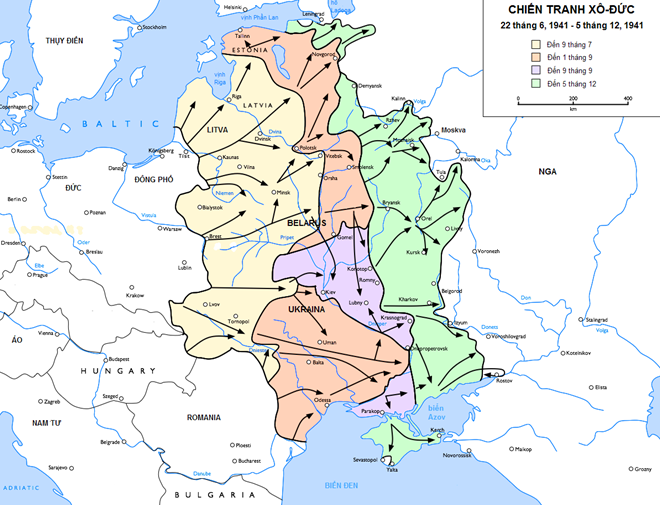On which front did Hitler’s most disastrous mistake take place?
On July 3, after seeing the war report and seeing that the Nazi army had reached the banks of the Dnieper River, even General Franz Halder – Chief of Staff of the Supreme Army Command (OKH), who was on duty continued to direct the planning Barbarossa, a rather cautious champion – also believing that “within a few more days, it will all be over”. But, then, it all took a different turn.
By the river Dnieper
Franz Halder has a factual basis for that belief, not a “will-only” belief as Adolf Hitler often had. He recorded in his diary: “The Red Army was tactically surprised on the whole front. All the bridges were intact. At every point along the border, the Soviets did not deploy troops to fight, and were all overwhelmed before they could organize a counterattack. Hundreds of their planes were destroyed before they could take off.”
On that June 22, 1941, the situation of the Red Army could be condensed into another story, recorded in the diary of another German officer – General Guenther Blumentritt: At dawn, German news stations captured the Red Army’s radio signal: “We’re under fire. What should we do?”. And the answer from Headquarters: “You guys are crazy. Why don’t you encode the signal?”.
Within days, tens of thousands of Soviet prisoners of war were captured; Each company was surrounded and isolated. By early July 1941, to the south, the Army of Marshal Von Rundstedt, consisting of 25 infantry divisions, 4 motorized divisions, 4 mountain divisions, and 5 armored divisions, had reached the banks of the Dnieper River. , close to Kiev.

By the middle of autumn 1941, the Nazi army was still proving to be overwhelmingly powerful.
Within a week, Field Marshal Von Leeb’s Army of the North (consisting of 21 infantry and 6 armored divisions) was crossing the Baltic republics, heading straight for Leningrad. In the front, Army Group Center commanded by Marshal Von Bock (including 30 infantry divisions and 15 armored and mechanized divisions) had advanced 700 km from northeastern Poland to Smolensk, leaving only 320 km from Moscow.
A line stretching 1,600 km from the Baltic Sea in the north to the Black Sea in the south had formed. Adolf Hitler was so confident that, on July 14, he ordered that Nazi Germany “prepare to be able to significantly reduce the strength of its army in the near future”, and that “weapons production could be focused on ships for the navy, as well as especially aircraft for the air force”, to “wage war with the last remaining enemy (in Europe) Britain, as well as against the America if necessary”.
By the end of September, he even began to consider demobilizing 40 infantry divisions, in order to have more manpower to work in industry.
Until then, autumn has not returned, and Russia’s terrible winter is still far away. Across the ocean, right in July, the American press was given information from the military (to inform readers) that the Soviet Union would collapse within a few weeks.
However, the reality was that after that, the Nazi armies could no longer maintain the rate of destruction as at the end of June. In fact, when he appeared before the Nuremberg military tribunal after the war, Marshal Von Rundstedt bluntly said: “Soon after the attack, I realized that everything I had heard about Russia was nonsense.”

But Adolf Hitler underestimated the power of the Soviet Union, and proved too greedy.
Subjective and objective causes
There is no denying it: The main reason that war machine was forced to stop and helplessly watch Russia’s terrible winter come when it was not fully equipped with necessities, was the fighting spirit. resilience and fierce counterattack from the Soviet Red Army.
Regardless of the loss of dozens of divisions in the early days of the outbreak, no matter how painfully watching large swaths of territory be trampled under the heels of an invasion, no matter the apparent lack of operational skill, In the war, the Red Army was finally standing, not only in the central line – where “Moscow was right behind”.
In parallel with the reports of field commanders, such as Panzer General Heinz Guderian, about violent clashes that caused heavy damage on both sides, General Blumentritt also recorded: “Red’s fighting spirit The army, even in one of the first battles like Minsk, was completely different from the Polish army or the Western Allies. Even when surrounded, the Russians still stood and fought.”
When the rear was too far from the front line, and the front line was also too far from the enemy’s rear, the Luftwaffe could no longer have the capacity to suppress. Meanwhile, the appearance of T-34 tanks was also a surprise that hindered the seemingly invincible power of German armor.

General Franz Halder – who kept a lot of valuable documents in his diary.
But, even in that context – the difficult situation that was clearly portrayed in front of the German generals’ eyes, Adolf Hitler’s “dreaming” was also a key reason why the Germans could not move forward with air. as ferocious as in the summer.
As revealed by Halder after the war: “The Army Command’s goal was to break the enemy’s military strength. Therefore, the next task must be to defeat the forces of Marshal Timoshenko, by concentrating concentrate all forces on Army Center, head straight to Moscow, capture the enemy’s command headquarters, continue to destroy enemy formations.”
If the Nazi army moves in this direction, the Red Army will probably have to spend a lot more blood and blood, but still have to accept leaving Moscow, implementing the strategy of “a garden without a house” that helped Nguyen. Marshal Kutuzov defeated Napoleon Bonaparte.
However, the Red Army did not need to do so, because Hitler chose to lead the way… the opposite. He demanded that Army Group Center (the strongest and most skilled) be… divided among the remaining two offensive directions.
What is the reason? In the North, Hitler wanted the Germans to be able to join hands with the Finns, and moreover, to capture Leningrad, as a symbol, while locking down the companies under Marshal Budiyoni.
In the South, Hitler’s ambitions were much more numerous. He both coveted industrial zones located on Ukrainian territory, and wanted to “plant” anti-Russian and pro-German ideologies in the territory of Western Ukraine that was close to the Prussian empire. He wanted to both occupy the oil fields in the Caucasus, and at the same time strengthen and protect the oil fields in Romania. Anyway, this is relatively understandable, because the Nazis were always hungry for fuel.
But not only that, in the south, Hitler also wanted to get close to reach out to help his Italian ally who was stuck in battles in Southern Europe. That is, Hitler was willing to put on an extra burden. Result: Army Group Center was forced to separate troops to support the other two directions, and the plan to attack directly to Moscow could not be stopped.
And that delay becomes an indefinite stagnation. Forever, Nazi tanks could not reach the streets of Moscow. As Halder observed: “It was the most disastrous strategic mistake on the Eastern Front.”
* Halder wrote in his diary, dated August 11: “It is becoming increasingly clear that we have underestimated the strength of the Soviet Union, not only economically, but above all militarily. Initially, I wished The enemy’s force was about 200 divisions. Now, about 360 have been identified. When dozens of divisions were annihilated, they immediately launched dozens of other divisions.On this vast front, our line was too thin, too lacking in depth. Therefore, the enemy’s continuous counter-attacks often achieved certain success.”
* Hitler instructed the German Army Command, August 21: “The most important goal to be achieved before winter is not to capture Moscow, but to capture Crimea, the industrial region and the coal mines of Donetsk, cut off Soviet petroleum supplies from the Caucasus”.
at Blogtuan.info – Source: danviet.vn – Read the original article here

